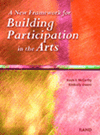A New Framework for Building Participation in Arts
When I was in junior high school and studying the piano with all the seriousness of adolescence, one of my friends expressed condolences that I had to take lessons every week. He was incredulous when I said I took them because I wanted to. In this regard my friend was a more typical kid than I was. The arts have always thrived in the fertile cultural and creative soil of the United States, yet Americans often are not encouraged to value artistic activities highly. In schools, the arts are the first to feel the effects of budget cuts.
Our society places a high premium on profit and practicality, and the arts often have little to do with either. As a result, arts institutions — especially the small nonprofit arts organizations that have proliferated dramatically in recent years — cannot take their constituencies for granted. In order to survive, they need to expand their audiences. For many organizations, fostering arts appreciation and community involvement is central to their mission, but there is an important practical side to this as well: expanding the market potentially broadens the revenue base. Raising funds has become more challenging as the emphasis by traditional arts funders — corporations, foundations, and the government — has shifted from the arts per se to the social and economic benefits the arts bring to local communities, such as creating a more livable environment, promoting a sense of community pride, and increasing the level of economic activity. This concern with the public benefits of the arts means that arts organizations must focus on increasing the public's access and exposure to the arts.
Institutions seeking to increase public participation must concentrate on strategy. Do they want to capture new participants within the existing market, increase current participants' involvement levels, or attract new markets with individuals who typically would not consider participating in the arts? Because most arts organizations do not have access to the information needed to address these issues, a study was initiated by RAND (a nonprofit institution that helps improve policy and decision-making through research and analysis) to better understand how individuals become involved with the arts and how arts institutions can influence this process. The findings of this study, which was sponsored by the Wallace-Reader's Digest Funds, are presented in A New Framework for Building Participation in the Arts. Authors Kevin F. McCarthy and Kimberly Jinnet explored literature on the subject, held site visits at 13 arts institutions, and conducted a telephone survey of 102 arts organizations that have received grants from the Wallace-Reader's Digest Funds and the Knight Foundation to encourage greater involvement in the arts.
They begin with a review of the literature that includes both empirical studies describing patterns of participation behavior and theoretical studies explaining this behavior. The chapter discusses such issues as why one form of participation may be more popular than others, why a person may choose one type over another, and who participates (those with more education or income and those who were exposed to the arts as children tend to participate more).
Recognizing that a decision to participate in the arts involves a complex variety of considerations, the authors have created a behavioral model of participation to help explain the decision-making process. This model consists of four stages: (1) background: whether to consider the arts a potential leisure activity; (2) perceptual: attitudes toward arts participation; (3) practical: the decision to participate; and (4) experience: actual participation and the reaction to this experience. This model can help organizations develop more effective strategies for increasing public participation because it recognizes that individuals may be at very different stages of the decision-making process and that a variety of factors will influence the decisions made at each stage. This in turn will affect the behavior-influencing strategies an organization will use.
Through their survey and site visits, the authors determined the tactics used by organizations to build participation. In most cases the organizations employed similar methods, suggesting that the main issue facing organizations is the selection of appropriate strategies for different target populations and at different stages. The authors' model offers a means of deciding which strategies to use by recognizing the relationship among the three main elements of the participation process: how organizations plan to increase participation, where their target populations presently are in the decision-making process, and the factors relevant to each position in the process. Evidence provided by the survey and site visits indicates that the most effective tactics must be targeted to specific groups, and that the flow of relevant information — both from participant to organization and from organization to participant — is crucial to the design and implementation of effective strategies. Moreover, organizations must use an integrative approach by considering how building participation fits with their mission and serves their ultimate purpose. Steps in an integrative approach include linking participation-building activities to core values and purpose, identifying target groups and developing tactics based on good information, understanding the organization's resources, and establishing a feedback and evaluation process.
The final chapter is a useful summary of the authors' conclusions about how arts institutions might best devise a plan for building public participation in their activities. Following this are appendixes that describe the results of the survey of the organizational characteristics and actual participation-building activities of 102 arts organizations. Although the findings do not necessarily typify all arts groups, they are significant because they represent the strategies of a large number of these groups. The organizations followed a similar approach, but they differed in their goals and tactics because these were dependent on the requirements of individual missions. Numerous tables and graphs help the reader interpret the data, and the book concludes with a useful reference list.
A New Framework contains valuable information and food for thought, logically presented and couched in language easily understandable by the lay reader. Arts organizations seeking to expand their base of participants will find it a significant resource and guide. With any luck, future generations of young pianists trudging off to their lessons after school will be the objects of envy rather than sympathy.
For citations to additional literature on this topic, refer to Literature of the Nonprofit Sector using the subject headings "Arts"; "Arts-analysis"; "Arts-marketing"; "Arts-handbooks, manuals, etc."; "Arts-studies"; "Performing arts".








